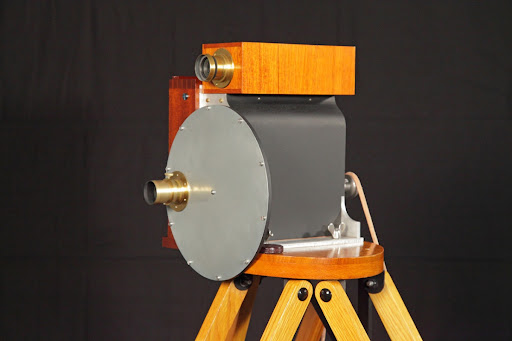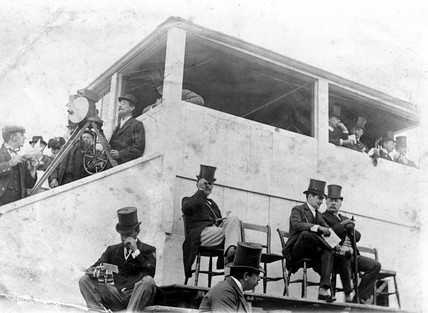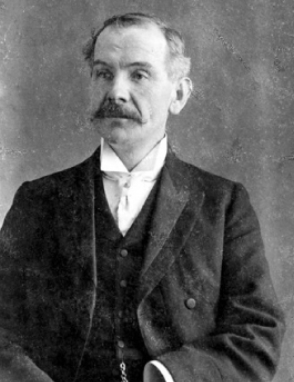Film historian and filmmaker chris izod takes us back to the turn of the 20th century, a really exciting time for theatre, photography and the moving image. Here, he shares with us the fascinating story of the “pioneer of the cinematograph” Birt Acres and his importance in the history of cinema.
Southend-on-Sea can claim that it was one of it’s citizens that invented the cinematograph – though we do need to share the honour with Barnet, Hertfordshire.
The inventor was Birt Acres, who lived in the borough. He lived first at St Vincents House, No 36 St Vincents Road, which was destroyed during the Second World War, then at 65 Victoria Avenue and finally in Park Crescent.

Acres was born to English parents in Richmond, Virginia USA in July 1852, and moved to Europe when his family was broken up during the American Civil War. In 1863 he was adopted by a wealthy aunt in France, and after being educated in Paris, he came to England.
Acres was always interested in photography and became manager of Elliott & Sons Dry Plate company at High Barnet, from there he moved to Southend-on-Sea in the 1890’s.
There can be little doubt that this invention made Birt Acres the originator of the cinematogrpah projector, several months ahead of his French rivals, the Lumiere brothers.
Whilst in Barnet, in 1893, he invented a camera which exposed a number of plates in rapid succession. From this he evolved a cine-camera, along a different line to that invented by William Friese-Green five years earlier. In the spring of 1894 Acres invented the first modern cinematograph projector. This was designed “to throw a series of images on a screen in rapid succession to convey the illusion of natural motion”.
From documents in the possession of the Acres family, there can be little doubt that this invention made Birt Acres the originator of the cinematograph projector several months ahead of his French rivals, the Lumiere brothers. The American claim that Thomas Edison invented the cinematograph is based on his ‘kinescope’ of 1889, which was simply a peepshow machine familiar on Piers and in old amusement arcades.

Although Friese-Green, whose early film of Hyde Park is well known, could claim to have made the first cinema film, it seems to have been Birt Acres who first developed the modern ‘newsreel’ technique. Acres first film, made in 1894, was of a haycart crossing Hadley Green in Middlesex – often credited to Louis Lumiere, several months before Louis and Auguste Lumiere’s famous film of an approaching train, throwing audiences in panic and setting the ladies screaming. But earlier in the following year, Mr. Acres was producing films of topical events.
In March 1895 he filmed the first British sports film and the first anywhere in the world of a regularly scheduled sporting event, the Oxford and Cambridge Boat Race. In May he filmed the first motion picture of a horse race, the Epsom Derby, then in July, he went to Germany to film the Kaiser opening the Kiel Canal.
In January 1896 Acres gave the first public screening at the London Headquarters of the Royal Photographic Society of films of Persimmon winning the Derby, and of the Henley Regatta.
In June 1896 Acres filmed the first news film shot in Britain. It showed the arrival of the Prince and Princess of Wales opening the Cardiff Exhibition. Acres secured special permission to film the Royal party on the condition that he himself was not seen. In order to achieve this, a small window was cut in a piece of canvas screen which formed one side of the walkway along which the Prince and Princess would approach the exhibition entrance. Since there was no hole in the canvas for the viewfinder, Acres had to begin shooting on a signal from a Royal official and hope the Royal party remained in shot. He filmed the whole scene without being able to see or frame his subject. This short film was also the first use of the 70mm film format.
In May of that year, he became the first person to present moving pictures to a paying audience outside London, at the Cardiff Town Hall. After these exhibitions, Acres abandoned the use of the 70mm gauge because of its high costs.
Buoyed up by his successes in early film exhibition Acres opened the first cinema in Britain at 2 Piccadilly Mansions at the junction of Piccadilly Circus and Shaftesbury Avenue on 21st March 1896. Admission was 6 old pennies, ( 2 1/2p). After only a few weeks in operation the cinema was gutted by fire.
At the invitation of the Prince of Wales, Acres gave what is considered to be the first Royal Command Film Performance in July, 1896 in a specially erected marquee in the gardens of Marlborough House for 40 royal guests at a dinner-party celebrating the marriage of the prince’s fifth daughter Princess Maud to the Prince of Denmark. The show proved so popular with the prince and his guests that the whole programme was repeated a second time.

The Prince of Wales is said to have christened the Acres projector the ‘Kinematograph’ which Acres had previously called the ‘kinetic lantern’ or ‘kineopticon’.
In 1898 Birt Acres produced a ‘home cinema,’ which combined camera and projector in one machine. Known as the ‘Birtac,’ this machine projected a picture 4ft by 3ft on to a screen from 18mm reels film. Instead of electricity it used gas, the pressure of the jet being boosted by a bag container in which the gas was stored and the pressure regulated by adding weights to the bag.
A year later he produced his first film in natural colours – at Buckingham Palace.
Like his rival William Friese-Green, Acres considered ‘sound’ a practical progression. His first ‘sound effects’, at the exhibition in 1900 of a film of the Barnet militia, were achieved by having men behind the screen playing bugles and marching on the spot to imitate the marching feet on his film.

As with so many inventors, Acres made little money out of cinema. Early in the 20th century he let his patents lapse.
Birt Acres started his own photographic supply business, and for many years had a factory in Wickford. He died in December 1918 and is buried in Walthamstow.
Chris Izod is a filmmaker from Southend-on-Sea, having a wealth of experience in film and television work over the last 50 years. A film historian and radio presenter, Chris also teaches technical theatre and television skills at Belfairs Academy. @IzodChris
If you’d like to write an article for us, do get in touch!
